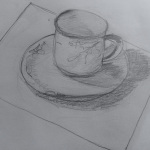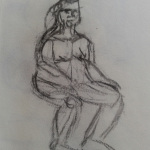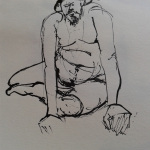Drawings by Svetlana, Drawing Academy student
Dear tutors,
I recently enrolled in the Drawing Academy course. I like it very much and look forward for every email you send me. Your advices are very helpful, thank you for sharing your knowledge!
Can you please check my sketches and advise what is the best way to improve my drawing skills?
Thank you very much,
Svetlana
Dear Svetlana,
Thank you very much for your sketches and drawings, we received everything you’ve sent.
First of all, I would like to say that it is great that you keep drawing and make various sketches, perspective studies, still-lifes, and drawing of live models. Well done! Only by practicing will you improve your drawing skills
You have certain drawing skills, but there is a room for improvement.
Here are the areas you might want to consider to work on:
1. Pencil handling and working position.
Do you have a feeling that your pencil marks and strokes do not always go where you want? Do you feel that your drawing style lacks some precision? If this is the case, you might need to practice pencil handling.
Make sure to use appropriate equipment – a vertically positioned drawing board, large-size drawing paper (approximately A2), a well-sharpened graphite pencil (it should be long, or extended with a pencil holder; pencil grade doesn’t matter, you may use HB for example), and two kinds of erasers – white and kneaded.
The Drawing Academy lesson on drawing materials will give you the necessary information on what pencils to buy and how to sharpen them correctly.
In regard to other drawing mediums, like charcoal, ink, colored pencils, red chalks, and so on, I would suggest for now that you concentrate on graphite pencil. Learn drawing techniques first, then expand your creativity with other mediums.
95% of all drawing lessons in the Drawing Academy course can be done in graphite pencil. We teach drawing principles that are applicable to every medium. Such universal principles include constructive drawing, the rules of perspective, golden proportions, rules of composition, the proportions and anatomy of the human body, etc. When you know how to draw whatever you want using those principles, then working in other mediums will be a natural extension of your skills.
Practice the correct “candle” pencil grip, as described in the Drawing Academy video lessons.
Draw various lines, strokes, and shapes. Draw short and long strokes, in various directions. Draw various shapes – squares, rectangles, circles, ovals, etc. Draw long vertical and horizontal lines. Strive for precision, so the marks and shapes appear exactly as intended.
Spend at least 10 hours on such exercises. Practice in multiple sessions over several weeks. Your hand has to get used to this new pencil grip before it becomes a natural and convenient way to draw.
Your goal is to achieve such handling that the pencil becomes an extension of your hand and mind. A pencil has to be your friend, not just a drawing tool.
2. Constructive drawing.
When a pencil becomes your best friend and you have no problem making meaningful marks as intended, continue with the principles of constructive drawing. Drawing geometric objects and simple still-lifes is a good way to do it. Check Drawing Academy videos dedicated to that topic.
Constructive drawing means using certain rules, such as drawing objects as if they were transparent; using virtual lines like axes of symmetry; lines that connect various edges and points; defining objects’ contours; applying linear perspective rules; drawing planes, edges, and cross-sections; and simplifying complex objects by sub-dividing them into simpler geometrical figures and shapes.
In constructive drawing, you “build” what you know about objects and their arrangement, not copying what you see. This is the main difference between drawing from life and copying from photos.
Spend at least 20 hours working on constructive drawing principles – draw simple objects in perspective from life and imagination, arrange them in still-life, and combine various objects.
Constructive drawing principles are not just for geometrical objects. They will help you to draw whatever you can see, remember, or imagine.
3. Shading techniques.
When you have a good understanding of constructive drawing principles, you can begin practicing shading techniques.
Follow the exercises proposed in the Drawing Academy video lessons. Use multiple layers of pencil strokes. Learn how to apply long and short strokes, strokes with variable pressure (you can start a stroke very light, go darker, and finish light), straight and curved strokes, parallel and cross-hatched strokes, strokes under different angles, and with different intensities, both very light and dark ones.
Spend at least 20 hours practicing pencil hatching techniques until you have perfected your pencil handling skills.
Achieve total control over the appearance of hatching lines under your pencil tip – light and dark, delicate and robust, short and long, curved and straight.
Do such exercise with various pencil grades – 2H, HB, or 2B, for example. Get the feel for how every pencil works, to get the most that one pencil grade can provide.
4. Human body proportions and anatomy.
In your figure drawings, you have drawn lines in the hope that some of them might fit the figure’s outline and complement the figure sketch. This intuitive approach seldom works. You are trying to copy what you see rather than draw what you know.
To improve your figurative drawings, you need to draw with the confidence that comes from knowledge and with practice.
Knowledge of the human figure can be acquired from multiple Drawing Academy video lessons on the proportions of the human body and its anatomy.
When drawing figures, their proportions and anatomy have to be considered together with constructive drawing principles.
For now, you can practice the exercises described above; afterwards, we will come back to portraiture and figure drawing.
Please let me know if you have any questions, I will be happy to assist.
To your creative success,
Vladimir











Dear Vladimir,
Thank you very much for your opinions and advice.
I cannot tell you how helpful your feedback is.
Before I started the Drawing Academy course I thought that I am very god at drawing,
but now I can see my mistakes. Thank you for opening my eyes.
I’m working on lines, strokes, perspective exactly as you told me.
Your help and guidance makes my day wonderful.
Kind regards,
Svetlana